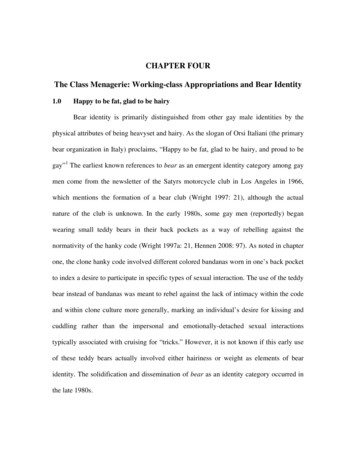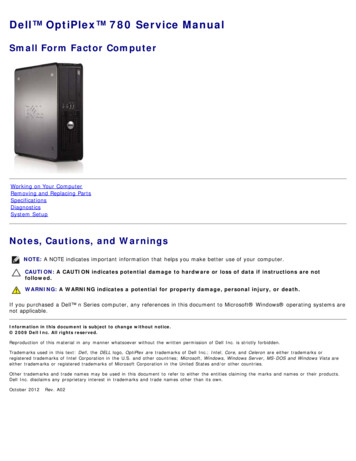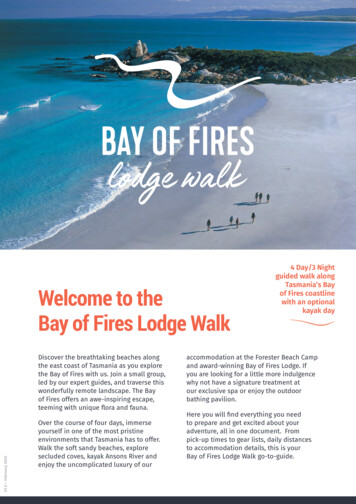
Transcription
BAFFIN BAY POLAR BEAR GENETIC MARKRECAPTUREINTERIM REPORT TO THE NUNAVUT WILDLIFE RESEARCH TRUSTDECEMBER 19TH, 2013NWRT PROJECT NUMBER: 2-13-25PROJECT LEADERS:GN Department of EnvironmentDr. Stephen AtkinsonBiologist (contract)Department of EnvironmentWildlife Research SectionGovernment of NunavutBox 209Igloolik, NU X0A-0LOPhone: (204) 284-1813Fax: (204) 284-1813sveveone@mymts.netMr. Markus DyckPolar Bear BiologistDepartment of EnvironmentWildlife Research SectionGovernment of NunavutBox 209Igloolik, Nunavut, X0A 0L0Phone: (867) 934-2183Fax: (867) 934-2190Mdyck1@gov.nu.caGreenland Institute of Natural ResourcesDr. Erik Born, GINRc/o Govt. of GreenlandRepresentation in DenmarkStrandgade 91, 3rd FloorP.O. Box 21511016 Copenhagen, DenmarkPhone (Direct): 45 32833825Fax: 45 32833801ewb@ghsdk.dkDr. Kristin Laidre, GINR and U. ofWashingtonPolar Science CenterAPL/University of Washington1013 NE 40th Street SeattleWA 98105-6698 USAPhone: 206-616-9030Fax: 206-616-3142klaidre@apl.washington.edu
SUMMARYThe Baffin Bay (BB) polar bear subpopulation has been the subject of significantdebate amongst government agencies, Inuit and other stakeholders. Differingperspectives on population size, trend and the sustainability of harvest levels,combined with a lack of current research, has generated uncertainty about thestatus of this sub-population. In response to this uncertainty, the Government ofNunavut in collaboration with the Greenland Institute of Natural Resourcesinitiated a study in 2011 designed to provide updated information on the size andstatus of the sub-population. Taking into account Inuit concerns regardingcapture and handling of polar bear in addition to a broader interest in thedevelopment of alternative monitoring techniques for polar bears, the study wasdesigned as a 3-year genetic mark-recapture program.Unlike methodspreviously used to study polar bears in BB, the study design does not require thecapture of polar bears. Instead biopsy darting is being used to obtain samples ofDNA which are then analysed in-order to identify individuals; in essence agenetic tag equivalent to the ear-tags and lip tattoos applied during previouscapture-based studies.Data collection for year 3 (2013) of the study took place in late August to earlyOctober along the eastern coastline of Baffin Island. In total, 420 polar bearswere biopsy darted. An additional 66 bears were encountered but not biopsied;37 of these being cubs-of-the-year. Preliminary review of data on the distributionand body condition of bears encountered in 2013 suggests possible differencesin comparison to other years of the study. In 2013, a greater proportion of bearswere found in the southern part of Baffin Bay (south of 70 degrees latitude) andbody condition tended to be poorer than in 2011. In addition to activities on theNunavut side of Baffin Bay, biopsy darting took place on the Greenland side in2013 to sample bears summering in this region. Since September 2011, tissuesamples have also been collected from bears harvested in Baffin Bay andsurrounding sub-populations in-order to monitor recovery of genetically taggedanimals by hunters in both Nunavut and Greenland.Genetic analyses of biopsy samples collected in Nunavut in 2011 and 2012 havebeen completed. Samples from bears harvested in Nunavut from BB andsurrounding sub-populations between September 2011 and July 2012 have alsobeen analysed. The 2013 biopsy samples and remaining harvest samplescollected in Nunavut are currently undergoing analyses. Biopsy and harvestsamples collected in Greenland during the study have been submitted foranalyses.OBJECTIVES1) To estimate the current abundance and composition of polar bears in BB.
2) To compare a new estimate of abundance with those derived from past studyin-order to gain insight into population trend and status in BB.3) To estimate survival and reproductive parameters (to the extent possible) inorder to facilitate population viability analyses.4) To evaluate polar bear distribution during the period of minimum sea-ice withrespect to environmental variables, particularly ice conditions, topography andfood availability distribution.5) To demonstrate the utility of genetic mark-recapture as a less invasivealternative to physical capture for the purpose of population monitoring.The objectives of the project remain unchanged from those originally proposed.MATERIALS AND METHODSThe basic study design was similar to that of the previous physical markrecapture study conducted in BB (Taylor et al. 2005) but did not involve theimmobilization and handling of bears. Instead, DNA extracted from a smallsample of skin and hair collected via a biopsy dart was used to identify eachbear; effectively genetically ‘marking’ each individual (and permitting futureidentification) without the need for ear-tagging or lip-tattooing. The ‘recapture’event occurred when a bear was either biopsy darted on a later occasion orwhen a DNA sample was recovered from a polar bear harvested by hunters ineither Nunavut or Greenland.From 2011-2013, biopsy darting was being carried-out along the coast of BaffinIsland in the fall (between August 20 and October 15th) coinciding with the timeof minimum sea-ice extent in each year. During this period, most bears in BB aredistributed on land or on the remaining pack-ice along the coastline of BaffinIsland and associated islands (Ferguson et al. 1997, 2000; Taylor et al. 2001).Two helicopters, each operating in different sections of the study area, are usedto search for bears. To reduce potential bias in sampling resulting from the nonrandom distribution of bears within the study area, including previouslydocumented segregation by sex and age-class (Ferguson et al. 1997; 2000), thestudy area was stratified into high, medium and low density areas using satellitetelemetry data on polar bear locations collected from collared bears in 1993-1997and 2008-2010 (figure 1). Search effort was concentrated within the high densitystrata along the coastline (up to 5 km inland) and offshore islands where bearsare known to congregate (Ferguson et al. 1997, 2000; Taylor et al. 2001, 2005).However, effort was also allocated to conduct searches of medium and lowdensity inland areas up to 10 and 30 km from the coast, respectively in-order to
sample bears further inland and at higher elevations1. Potential sampling biaswas also minimized through the use of a multi-year sampling design and by theaddition of biopsy sampling efforts along the Greenland side of Baffin Bay in thefall of 2012 and 2013; concurrent with the main sampling effort along BaffinIsland. Finally sampling heterogeneity associated with bears that may occupypack-ice that is inaccessible by helicopter, was reduced by using sea-ice dataand telemetry data from collared bears to time fieldwork to coincide with theperiod of minimum ice when the vast majority of bears are on land.Once a bear was located, a small sample of tissue ( 5 mm diameter), mostlyskin, was taken using a biopsy dart fired from a dart rifle from the helicopter. Thedarts are designed to fall to the ground after impact and can be retrieved withouthandling a bear. For each bear observed, GPS coordinates and information onlocation, behavior, body condition, estimated age/sex (when possible) andgroup/litter size were recorded. DNA extracted from biopsy and harvest tissuesamples was analyzed in-order to assign each bear sampled (and re-sampled)during the study a unique genetic identity and determine its sex.PROJECT SCHEDULEThe project remains on schedule as originally proposed with final resultsexpected in winter 2014/15.OUTPUT OR STEPSTART DATEEND DATEPERSONDAYSLogistical preparationsSpring 2011Summer 201165Spring 2012Summer 201220Spring 2013Summer 201320September 2011October 201180September 2012October 201280September 2013October 201380Harvest samplingFall 2011Fall 201375Analysis of tissue samplesWinter 2011/12Winter 2013/14 -Final data analyses,Winter 2013/14preparation of reports and peerreviewed publicationsWinter 2014/15 -Biopsy dartingPRELIMINARY RESULTS & DISCUSSION1Based on the frequency of telemetry locations occurring within each stratum, approximately 85, 10 and5% of search effort is allocated to searching in the high, medium and low density strata respectively;subject to limitations imposed by weather and terrain which do not always permit inland searching.
Sampling Effort:In 2013 (year 3 of the project), biopsy sampling was carried out along the eastcoast of Baffin Island from August 20th to October 11th. During this interval,Canadian Ice Service charts indicated Baffin Bay was virtually ice-free and allsatellite-collared bears present in the study area were located on land. It wasthus assumed that a majority of bears in the sub-population were available for‘capture’ at the time of biopsy sampling2. The timing and length of this samplingperiod differed slightly from previous years (figure 2) due to availability of aircraftand weather conditions. In comparison to the 2011 and 2012 sampling sessions,weather conditions were poor in 2013 resulting in extension of the samplingwindow in-order to adequately cover the study area and obtain sufficientsamples.Two Bell 206L helicopters operating in different sections of the study area wereused to search for and biopsy dart polar bears. The helicopters were initiallypositioned at the community of Pond Inlet and the Cape Dyer DEW line site tocover the northern and southern halves of the study area, respectively. Bothhelicopters were tasked with working towards Clyde River. HTO members fromthe communities of Qikiqtarjuaq, Clyde River and Pond Inlet assisted in the field.In addition to sharing their knowledge of polar bears and the local terrain, theseindividuals worked as observers helping to locate and in some cases biopsy dartbears. Parks Canada staff (Sirmilik National Park) also served as observers.In total, 486 bears were encountered during field operations of which 420 (86%)were biopsied (Table 1). Of the 66 bears that were not biopsied, 56% were cubsof-year for which biopsy darting was considered an unsuitable/unsafe practicebased on size, risk of separation from mother or risk of injury from pursuit. Theremaining individuals were those encountered in situations where biopsy dartingwas impractical or unsafe (i.e. narrow ledges, insufficient fuel, within dens, openwater in high waves etc). Ninety-three percent of encountered bears 1 year ofage or older were biopsied.To the extent possible, search effort was distributed systematically across thestudy area according to previously established strata but was modified asnecessary in response to terrain and weather conditions that constrained accessto some areas. Flight paths during searches were recorded via GPS and willallow post-hoc assessment of the distribution of search effort. Concerted effortwas made to search inland and at high elevations. All fiords, with the exceptionof 3, and most ( 95%) islands within the study area were searched. Inland flightsextended up to 30 kilometers inland.2As is normal in Baffin during this period, icebergs were present offshore drifting in a southerly directionthalong the coast of Baffin Island. However, ice-cover was less that 1/10 according to Canadian Ice Servicedata.
Similar to 2011 and 2012, encounter rates varied significantly across the studyarea and amongst sampling days depending on the distribution of bears, terrainand weather conditions. Average overall encounter rate was approximately 1.6bears per hour of flying compared to 2 and 2.6 bears per hour in 2011 and 2012respectively3. The encounter rate during active search effort has not yet beencalculated but is expected to be approximately 2 bears per hour. Based on ourperceptions, the lower encounter rate in 2013 was the result of poor weatherconditions, which limited access to some parts of the study area and the visibilityof bears, combined with lower densities within searched areas and/or differingdistribution amongst the strata.Because biopsy darting leaves no visible marks, the sample of 420 biopsiedbears may include individuals that were sampled more than once during the 2013field season. However, the number of duplicate samples is expected to be lowand can be determined once genetic analyses are completed. Several measureswere taken to avoid repeated biopsy of individual bears. Daily searches werelimited to areas not previously searched. Whenever possible, natural barriers tomovement were used to delineate neighbouring search areas. In situationswhere multiple bears were encountered at the same location duplication ofsampling was avoided by distinguishing individuals based on size, sex or visiblemarks (e.g. scars, stains on fur etc.). When distinguishing amongst individualswas not possible, some bears were sampled using a dart (Pneudart Inc.) thatsimultaneously biopsied and marked bears with a temporary dye spot.The biopsy darting was found to be quick and minimally invasive. The timebetween spotting a bear and obtaining a sample was typically less than 2minutes. Since the bears were not being chemically immobilized they could besafely darted in locations that would have been unsuitable for capture due to therisks of drowning or falling. The only exception was for bears found in the water.These individuals were moved to land before darting since the biopsy darts donot float.4 Bears showed little or no reaction to the impact of a dart and no visiblemarks were left following darting in almost all cases. Immediately after beingdarted, each bear was allowed to safely move away from helicopter before thedart was retrieved. Darts were coated in fluorescent paint to aid retrieval. Alength of flagging tape was also rolled around the shaft. This tape unrolledduring flight and allowed darts to be easily located especially when they sank intothe snow. Following retrieval each sample was divided into two parts. Thesubsamples intended for DNA analysis were dried and stored in individualenvelopes.Anecdotal observations (Born et al. 2011) and recent satellite telemetry studiesof bear movements (2009-2013: Born & Laidre unpublished data) indicate that3Includes non-search (ferry) time.It was discovered part way through the season that the DNA/dye marking darts sometimes floated thusallowing retrieval from water under calm conditions. Two bears were successfully darted while in thewater.4
some polar bears summer along the coast of Greenland, in particular in theMelville Bay area of north-eastern Baffin Bay. Although probably small, thefraction of the Baffin Bay population summering in this region is unknown.Furthermore, it is unclear whether these bears show year-over-year fidelity toGreenland. If bears do show seasonal fidelity to Greenland, reliance on biopsysampling along Baffin Island could lead to underestimation of population size. Toaddress this potential source of bias, biopsy sampling of bears took place on theGreenlandic side of Baffin Bay in 2012 and 2013. In 2013 a total of 17 bearswere encountered in this region during fieldwork in the early September, fourteenof which were biopsied (E. Born pers comm.). In comparison to biopsy dartingactivities along Baffin Island, encounter rates in Greenland were very low (e.g.0.4 bears per hour of active searching in 2012). This finding is consistent withprevious evidence suggesting densities are low in this part of Baffin Bay duringthe open water season.Distribution:The distribution of biopsy sampling in 2013 is illustrated in figure 3a. Asexpected, and similar previous years, encounter rates were highest close to thecoast and on islands. A significant number of bears were encountered in thelong, steep sided fiords of eastern Baffin Island often at the head of fiords aroundthe outflows of glaciers and rivers. Bears were found in a wide variety of habitatsincluding coastal plains, beaches, boulder fields, scree slopes, cliff faces,vegetated hillsides, mountain tops, glaciers, ice-bergs.At time of firstobservation some bears were found occupying shallow pits along shorelines or insnow dens at higher elevations. Five percent (23) of encountered bears werefound swimming and were successfully biopsied.Based on clustering of polar bear movements and sea-ice dynamics, Taylor et al.(2001) describe a boundary at approximately 70 degrees latitude dividing BaffinBay into two sub-units; Northern Baffin Bay (NBB) and Southern Baffin Bay(SBB). Using the same delineation of north and south to summarize thedistribution of polar bear encounters in Baffin Bay during biopsy darting (Table 2)suggests that the distribution of encounters in 2013 was similar to that of 20122but significantly different from 2011 (χ 90.27, d.f. 2, p 0.01). In 2011,sampled bears were relatively evenly distributed between northern and southernBaffin Bay. In contrast, during 2012 and 2013 a majority of bears (70%) wereencountered in SBB. Since the effort allocated to searching in these two regionswas approximately the same within and between years, these differences indistribution are likely real rather than the result of sampling bias. However, it isnoted that there were also differences amongst years in terms of timing ofsampling and personnel conducting the sampling that may have influencedencounter rates in these two regions. For example, in 2011 a majority of thesampling effort in both regions was conducted by the same field team. Incontrast sampling effort in 2012 and 2013 was more evenly split between twofield teams with each team focusing a majority of their effort in NBB or SBB.
Whether there are interactions between factors such as observer, timing ofsampling, timing of sea-ice break-up and capture probabilities across the studyarea is unclear at present but will be examined during analysis. Future analyseswill also examine data on distribution of bears during the ice-free season ingreater detail in relation to environmental variables (objective #4) and themovements of instrumented bears.Reproductive Indices:During the 2013 sampling session, 80 family groups were encountered including49 adult females with cubs-of-the-year (COY), 30 with yearlings and 1 with 2year-olds. Litter size ranged from 1 to 3 offspring; including 1 group of tripletCOYs. Mean litter size for yearlings was 1.37 (S.E. 0.09); the lowest recordedin the 3 years of sampling (Table 3). Litter size amongst COYs was 1.63 (S.E. 0.08); the highest recorded in the 3 years of sampling. COYs and yearlingsmade up 16% and 8% of the sampled bears respectively; similar proportions to2011 and 2012 sampling in BB and comparable to recent sampling in otherseasonal sea-ice populations with the exception of Western Hudson Bay (2011)and Davis Strait (2005-2007). Anecdotally, some (4 individuals) of the COYsencountered in the fall of 2013 were noted to be unusually small; about the sizetypical of a COY in the spring. Similarly undersized cubs were observed in 2012but not in 2011.Body Condition Indices:Bears were assigned a body condition score on a scale of 1 to 5 based on visualassessment with those in the poorest and best condition being rated as 1’s and5’s respectively (Stirling et al. 2008). Data for 2011-2013 are summarized intables 4 to 6. In all years, most (75%) of the bears encountered were rated asbeing in average body condition (i.e. score of 3). A cursory examination of thesedata suggests possible differences in body condition between years with bears in2011 tending to be in better condition than in 2012 and 2013. Further analysesof body condition data will be conducted.Foraging Observations:Observations on foraging by polar bears were collected opportunistically duringfieldwork in 2013. Similar to 2012, forty-two (9%) bears encountered exhibitedevidence of feeding (Table 7). Evidence of feeding ranged from directobservations of feeding at the time of encounter (9 individuals), and indirect signsof recent feeding activity including: Oil stained fur (6); blood stains around themouth (4); distended abdomens (23); the production of feces during pursuitcharacteristic of bears feeding on marine mammals (11), proximity to char runs(6).
Bears were encountered feeding, or showing signs of having recently fed, onwalrus, ringed seal, narwhal and fish. At two locations, congregations of bearswere encountered along streams where char were observed running. Fishcarcasses found at these sites and the presence of bears standing in closequarters along these watercourses suggest bears were actively fishing.Genetic Analyses:Genetic analyses of biopsy samples collected in Nunavut in 2011 and 2012 havebeen completed. Samples from bears harvested in Nunavut from BB andsurrounding sub-populations between September 2011 and July 2012 have alsobeen analysed.The following samples are currently being analysed or are pending submissionfor analyses: Samples from bears biopsied in Nunavut in 2013 and from bears biopsiedalong the west coast of Greenland in 2012 and 2013.Samples from bears captured along the west coast of Greenland for theperiod 2009-2013.Samples from bears harvested in Nunavut from BB and surrounding subpopulations for the period August 2012 to October 2013.Samples from bears harvested in Greenland for the period September2011 to September 2013.REPORTING TO COMMUNITIES/RESOURCE USERSFollowing consultation meetings in 2011, the project received unanimous supportfrom all 3 affected HTO’s. Consultation prior to the 2013 fieldwork took place viacorrespondence as planned. A version of this progress report will be distributedto HTO’s in 2014. Consultations regarding project results will take place in eachcommunity in late q/NativakHTOFeb 2010, incommunity(completed)Fall 2011 &2012, incommunityduring fieldworkFall 2014, incommunityFeb/March2011, incommunity(completed)Clyde River/NamautaqFeb 2010, incommunityWinter 2011,2012 & 2013,bycorrespondenceFall 2011, in-Fall 2014, in-
HTOPond Feb/March2011, incommunity(completed)Winter 2011,2012 & 2013,bycorrespondenceFeb 2010(completed)Fall 2011/12, in- Fall 2014, incommunitycommunityFeb/March2011, incommunity(completed)Winter 2011,2012 & 2013,bycorrespondenceREFERENCESBorn, E.W., A. Heilmann, L. Kielsen Holm, and K. Laidre 2011. Polar bears inNorthwest Greenland – An interview survey about the catch and the climate.Monographs on Greenland – Man and Society Vol. 41. Museum TusculanumPress, University of Copenhagen: 232 pp.Ferguson, S.H, Taylor, M.K., and Messier, F. 1997. Space use of polar bears inand around Auyuittuq National Park, Northwest Territories, during the icefree period. Can. J. Zool. 75:1585-1594.Ferguson, S.H., M.K. Taylor, and F. Messier. 2000. Influence of sea icedynamics on habitat selection by polar bears. Ecology 81:761-772.Peacock, E., Laake, J., Laidre, K., Born, E., Atkinson, S.N. (2012). The utility ofharvest recoveries of marked individuals to assess polar bear (Ursusmaritimus) survival. Arctic 65: 391-400.Stirling, I., Thiemann, G.W. and Richardson, E. (2008). Quantitative support for asubjective fatness index for immobilized polar bears. Journal of WildlifeManagement 72(2):568 – 574,Taylor, M.K., S. Akeeagok, D. Andriashek, W. Barbour, E.W. Born, W. Calvert,H.D. Cluff, S. Ferguson, J. Laake A. Rosing-Asvid, I. Stirling and F. Messier.2001. Delineating Canadian and Greenland polar bear (Ursus maritimus)populations by cluster analysis of movements. Can. J. Zool. 79:690–709.Taylor, M. K., J. Laake, P. D. McLoughlin, E. W. Born, H. D. Cluff, S. H.Ferguson, A. Rosing-Asvid, R. Schweinsburg, and F. Messier. 2005.
Demography and viability of a hunted population of polar bears. Arctic58:203-214.White, G. and K. Burnham. 1999. Program MARK: survival estimation frompopulations of marked animals. Bird Study 46:120-139.
Table 1. Summary of biopsy sampling in Baffin Bay (Nunavut) 2013 according to ageclass and sex as estimated by distance examination.Age 500470666Table 2. Number of polar bears encountered in Northern and Southern Baffin Bayduring biopsy sampling in 2011 to 2013. Proportion of observations within each year arein parenthesis.Year201120122013Northern Baffin Bay278 (0.553)216 (0.302)154 (0.317)Southern Baffin Bay225 (0.447)499 (0.698)332 (0.683)
Table 3. Polar bear litter sizes and number of dependent offspring observed (as proportion of total observations) during recent icefree season studies in central and eastern Canada. Litter size data presented as mean (standard error).SubpopulationLitter SizeProportion of Total ObservationsSourceCubs of the yearYearlingsCubs of the yearYearlingsBaffin Bay (2013)1.63 (0.08)1.37 (0.09)0.160.08GN (unpublisheddata)Baffin Bay (2012)1.47 (0.06)1.53 (0.08)0.130.10GN (unpublisheddata)Baffin Bay (2011)1.57 (0.06)1.51 (0.09)0.190.10GN (unpublisheddata)Western HudsonBay (2011)1.43 (0.08)1.22 (0.10)0.070.03Stapleton et al.(2012)Southern HudsonBay (2011)1.56 (0.06)1.54 (0.08)0.160.12M. Obbard(unpublished data)Foxe Basin (20092010)1.54 (0.04)1.48 (0.05)0.130.10Stapleton et al.(2011)Davis Strait (20052007)1.49 (0.15)1.22 (0.28)0.080.09Peacock et al. (2013)
Table 4. Summary of body condition scores (BCS) for polar bears encountered during biopsy sampling in Baffin Bay (Nunavut) 2012.Age and sex estimated by distance examination. Body condition score rated 1-5; poorest condition 1, best nknownMaleFemaleUnknownMaleFemale (with offspring)Female (without ble 5. Summary of body condition scores (BCS) for polar bears encountered during biopsy sampling in Baffin Bay (Nunavut) 2012.Age and sex estimated by distance examination. Body condition score rated 1-5; poorest condition 1, best 5.Age UnknownMaleFemaleUnknownMaleFemale (with offspring)Female (without offspring)UnknownAdultTOTAL12326013Body Condition 953347566TOTAL9469115020107150115911708
Table 6. Summary of body condition scores (BCS) for polar bears encountered during biopsy sampling in Baffin Bay (Nunavut) 2011.Age UnknownMaleFemaleUnknownMaleFemale (with offspring)Female (without offspring)UnknownAdultTOTAL111Body Condition 3TOTAL945124293412395474501
Table 6. Evidence of feeding by polar bears encountered during biopsy sampling, 2013ClassCOYYearling2-Yr-OldSub-adultAdult Female(with offspring)Adult Female(alone)Adult MaleTOTALEvidence ofFeedingYesNoFood Source (Known or riesUnknown131-34365221-312478943352160720
Figure 1. Stratification of the study area
Figure 2. Timing of biopsy sampling along Baffin Bay during 2011, 2012 and 2013.August201120122013SeptemberSept 4 – Oct 14Aug 26 – Sept 29Aug 20 – Oct 11October
Figure 3. Distribution of polar bear encounters along Baffin Bay during biopsy dartingactivities in (a) 2013; (b) 2012; (c) 2011 and (d) capture operations, 1993-1997. Circlesrepresent location of one or more polar bears.(a)
(b)
(c)
(d)
Igloolik, NU X0A-0LO Phone: (204) 284-1813 Fax: (204) 284-1813 sveveone@mymts.net Mr. Markus Dyck Polar Bear Biologist Department of Environment Wildlife Research Section Government of Nunavut Box 209 Igloolik, Nunavut, X0A 0L0 Phone: (867) 934-2183 Fax: (867) 934-2190 Mdyck1@gov.nu.ca Greenland Institute of Natural Resources










